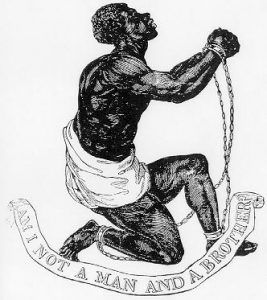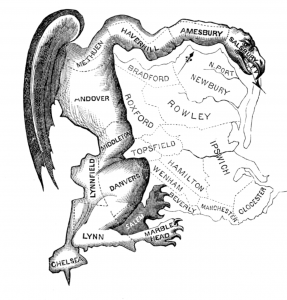by Jonathan Kujawa

Despite what he may wish, the President of the United States is not a king. We have Congress to act as a check and to ensure the varied opinions of the citizens are represented [1]. In principle, a representative democracy is straight-forward: the voters vote, select their representatives, and the legislature gets down to the business of running the country.
The devil, of course, is in details. The framers of the Constitution had knock-down, drag-out fights over basic questions like: does the legislature represent individual citizens or the states? On one side you had those who saw the new country as a joining together of independent, co-equal states. William Patterson of New Jersey compared a large state having more votes than a small one, to the idea “that a rich individual citizen should have more votes than an indigent one”. Those on the other side took the view if this is to be a true common enterprise, then every voter should be treated equally regardless of where they happened to reside. In what can only be a coincidence, a founder’s position on the issue almost invariably matched whether they came from a large state or a small one.
They finally agreed the Senate would have two representatives from each state, regardless of size, while the House of Representatives would have its members allocated to the states according to their population. Even this reasonable compromise nearly failed.
Under threat the union might fail entirely, the proposal passed by a single vote with North Carolina deserting its large state allies to vote in favor [2,3]. The framers then laid out the rules on how to form the House of Representatives in Article I of the Constitution. In its entirety, it reads:
Representatives and direct taxes shall be apportioned among the several states which may be included within this union, according to their respective numbers, which shall be determined by adding to the whole number of free persons, including those bound to service for a term of years, and excluding Indians not taxed, three fifths of all other Persons. The actual Enumeration shall be made within three years after the first meeting of the Congress of the United States, and within every subsequent term of ten years, in such manner as they shall by law direct. The number of Representatives shall not exceed one for every thirty thousand, but each state shall have at least one Representative;
That is, representative democracy is achieved in three easy steps:
- Every ten years Congress is to organize a census to count all the citizens of the country.
- Using that data, Congress shall apportion representatives according to the states’ respective numbers.
- Since it is not expressedly assigned to the federal government, it is up to the states to determine how their representatives should be selected by the voters.
 Mathematically, the first is simple arithmetic. Every ten years Congress is charged with counting every person living in the country. Significantly, the founders made clear that it wasn’t just citizens who should be counted. Every free person, including indentured servants, should be included. It also probably wasn’t too controversial to decide to exclude the untaxed Native Americans. I don’t think many at the time would have argued the member of a tribe in the far West who neither paid towards, nor benefited from, the federal government should be accounted for when determining representation. Then there was infamous 3/5 compromise. With no observable sense of irony, the slaveholding states argued slaves should count as people for the census (but, evidently, not for anything else), while the other states wanted them discounted entirely. This led to another knock-down, drag-out fight over the relative balance of power between the states. Somehow they settled on the odious determination that a slave was 3/5 of a person.
Mathematically, the first is simple arithmetic. Every ten years Congress is charged with counting every person living in the country. Significantly, the founders made clear that it wasn’t just citizens who should be counted. Every free person, including indentured servants, should be included. It also probably wasn’t too controversial to decide to exclude the untaxed Native Americans. I don’t think many at the time would have argued the member of a tribe in the far West who neither paid towards, nor benefited from, the federal government should be accounted for when determining representation. Then there was infamous 3/5 compromise. With no observable sense of irony, the slaveholding states argued slaves should count as people for the census (but, evidently, not for anything else), while the other states wanted them discounted entirely. This led to another knock-down, drag-out fight over the relative balance of power between the states. Somehow they settled on the odious determination that a slave was 3/5 of a person.
Aaron Sorkin supposedly said, “You just say the word ‘census’ and people fall asleep.” Nevertheless, the census continues to be a source of political warring. Just look at the furor raised by the plan to ask respondents about their citizenship status during the 2020 census.

The third step to a representative democracy is simple geometry. While in the early days some states opted to have their representatives chosen by state-wide ballot as they do for the Senate, in 1842 Congress used its power to set election standards and required all representatives to be elected from single member districts. That is, each voter should select one and only one member of the House of Representatives. While the law changed over the years and Article I was modified by the 14th amendment, the requirement to have single member districts remained. This reduces step three to the problem of dividing states into districts. But since the deviousness of politicians knows no bounds, this inevitably led to ever more torturous efforts to gerrymander.
Two and a half years ago we ran into gerrymandering here at 3QD. We talked about a pretty naive measure of gerrymandering which I called “distortion”. It gives a rough measure of the compactness of a region. A circle has the smallest possible distortion (about 12.6) with North Carolina’s infamous districts 1 and 2 having a distortion of 315 and 426, respectively. There are dozens of different measures to detect gerrymandering which are much more sophisticated, but they all have the same defect as distortion. They try to capture gerrymandering by looking at geometric features of the district to look for signs of over-manipulation. Unfortunately, the power of computers and huge troves of fine-grained data allows districts to be constructed which easily pass both the “eyeball test” and the many geometric tests. They look nice, compact, and entirely reasonable, but give results which are vanishingly rare except by design. Fortunately, geometers have risen to the challenge of sniffing out gerrymandering.
This spring Moon Duchin visited my home department to give a talk about her work on detecting gerrymandering. She and her collaborators take the approach of thinking of each possible redistricting map for a given state as a spot in what we could call Redistricting Space for that state. We’ve seen this philosophy of thinking of a collection of geometric objects as a single geometric space here and here at 3QD. This is a powerful technique which is frequently used by researchers in geometry. The problem is there are unimaginably many different redistricting maps; Redistricting Space is vast and impossible to know completely.
Two spots are close by in Redistricting Space if you could get from one redistricting map to another by just tweaking a boundary or two. By repeated doing such tweakings, you can “walk” your way around Redistricting Space. By randomly choosing a tweak at each step you’ll meander around Redistricting Space like an inebriated college student aimlessly wandering across campus.
Dr. Duchin and collaborators apply the well-developed theory of random walks in exotic spaces to the problem of gerrymandering. Specifically, they use mathematics to show, after a long enough random walk, you will find yourself at a truly arbitrary redistricting map. You do this a few million times on a computer and you’ll get an excellent sampling of Redistricting Space. Using this, you can precisely describe if a given map is an extreme outlier, or not [4]. While gerrymandering will be a hugely contentious topic for the foreseeable future, the work of Moon Duchin, Jonathan Mattingly, and other mathematicians gives me hope step three is manageable.
That leaves us with step two of forming a House of Representatives. Once the census count has finished, it is simple algebra to divvy up the 435 members of the House of Representatives among the states in proportion to their size. Right? Right?? I have to confess I had never thought about the problem of apportionment until I saw Dr. Duchin’s talk. Unlike the census and gerrymandering, I had certainly never heard it discussed on the news. It turns out we are in a quiet period which, I fear, is nothing but the eye of the storm.
This is a problem of fair division, which we touched on here at 3QD. There is a large, active area of research on the mathematics of fairly dividing things into groups, even when fair means different amounts for different people. There are many results which show that under favorable circumstances you can always find a fair division. Unfortunately, these results almost always require that we can make arbitrarily fine adjustments to our cuts.

Reapportionment is a Solomonic problem. If a state has 18.7% of the population of the country, then they should have 81.345 of the 435 members of the House of Representatives. We call this number the state’s quota. As much as we may wish, we are not allowed to cut out .345 from a Congressman to represent this state. Somehow we have to turn each state’s quota into a whole number. This is the problem of apportionment.
Dealing with this fraction of a Congressperson has been a conundrum from the beginning. After the first census in 1790, Hamilton proposed Congress should take every state’s quota and round down; regardless if you have a quota of 7.23 or 7.93, round it down to 7. This leaves you with leftover, unassigned representatives. Going back to the original list of quotas, give an extra representative to each state which has an extra fraction of a representative, the one with the largest fractional quota first, until you run out of extra representatives. So you would give an extra representative to the 7.93 state (giving them 8). If you had enough spare representatives to go around, eventually you would give one to the 7.23 state. If not, they would be left at 7 representatives.
Hamilton’s system sounds fair unless you are a state with a quota of 7.65 which gets rounded down to 7 and you never get an extra representative. While this proposal passed Congress, it was controversial and at Jefferson’s urging, it was vetoed by President George Washington. In fact, this was the first of only two times Washington used his veto power! The official reason was it caused Delaware and Connecticut to have fewer than 30,000 people per representative, and hence violated Article I of the Constitution [5].
Since they were unable to override Washington’s veto, Congress instead went with Jefferson’s plan to uniformly reduced the denominator when calculating states’ quotas to the point where if you round down every state’s quota, you have exactly the number of congresspeople needed (that is, rounding down leaves no leftover, extra representatives which need to be assigned). Jefferson’s rule was used for several decades, but in 1832 it would have led to New York’s quota of 38.59 giving them 40 seats. Everyone was unhappy with a system which could result in a rounding up by more than 1 (Except New Yorkers!). Congress instead went with a method suggested by Daniel Webster. Like Jefferson, Webster would have you uniformly tweak the denominator when calculating quotas, but instead of always rounding down, you round down or up in the usual, everyday way.
Since apportionment is set by Congress, it was a decennial fight to determine the method. In smoky back rooms, calculations were worked out to see which method favored which party and battles were fought. Even worse, the number of Representatives wasn’t fixed, so that gave Congress another dial to turn when gaming the outcome. Finally, in 1929 Congress passed a bill which specified that, barring passage of a new law, apportionment should be always be done by the method used after the previous census. This cooled tempers, has kept us using the same apportionment method for a century, and kept the House of Representatives at 435 members.
So how do we apportion representatives these days? We use the Huntington-Hill method. It was proposed by a pair of mathematicians in the early 2920s [6]. It is similar to the Jefferson and Webster methods in that it depends on uniformly tweaking the denominator when calculating the states’ quotas.
The innovation is in the rounding [7]. Jefferson always rounded down (so 1.1, 1.49, and 1.8 all round down). Webster did everyday rounding where the cut-off between rounding down and rounding up is at the half-way mark (so between 1 and 2 the cutoff is 1.5: 1.1 and 1.49 round down, and 1.8 rounds up). Huntington-Hill uses the geometric mean as the cut-off for rounding. The geometric mean of 1 and 2 is √2 ~ 1.4142, so H-H round 1.1 down, but 1.49 and 1.8 both round up.
If you are considering numbers between a and a+1 and want to round, you usually use the ordinary arithmetic mean as the cut-off. This is the usual average of the two numbers where you take their sum and divide by two: (a+a+1)/2 = a + 1/2 and is the midpoint between the two. The geometric mean is instead taking their product and taking the square root: the geometric mean of a and a+1 is given by √(a(a+1)).
Why the heck would you ever use the geometric mean? It is mainly used in situations where you want to ignore the scale by which you are measuring things and instead compare relative differences. For example, say you want to consider the average of the salaries of Jeff Bezos and myself. If you use the usual arithmetic mean, then if Bezos’s salary goes up by 20% it has a much larger effect on the mean than if my salary goes up by 20%, because the two salaries are on wildly different scales. However, the geometric mean of our salaries would respond exactly the same to a 20% rise in either one of our salaries. The geometric mean is used in economics, meteorology, physics, and other places where you want a 10% change to be treated the same regardless of the size of the number involved.
Why then is it used in the Huntington-Hill method? As Huntington explains in his paper, it is reasonable to want the ratio of the number of representatives vs. a state’s population to be as similar as possible among the various states [6]. What does similar mean? One reasonable definition is if you divide this number for one state by the number for another state, you want to always be as close to 1 as possible. That is, you are comparing the proportional difference in these numbers. That leads you to use the geometric mean.
There are other arguments you can make for the Huntington-Hill method, but it isn’t perfect. In fact, its main virtue is it is just complicated and intimidating enough to keep Congress from trying to fiddle with it. Eventually, the politicians will figure out apportionment is another way to choose their voters [8]. One of these days we’ll be cast out of the quiet garden provided by the Huntington-Hill rule.
Since we know there are perfect fair division algorithms, you might rightly ask if there is a perfectly fair way to do apportionment. Sadly, no. In 1983 the mathematicians Michael Balinski and Peyton Young proved you can’t possibly have a perfect apportionment system. More precisely, say you want your apportionment rule to satisfy:
- Every quota is rounded up or down by at most 1 (ie. if your quota is 9.23, you will receive either 9 or 10 representatives).
- You avoid the “Alabama Paradox”: if the total number of available seats goes up, no individual state’s allotment goes down as a result.
- You avoid the “Population Paradox”: if the population of state A goes up and the population of state B goes down, it doesn’t happen that representatives end up transferred from state A to state B.
The Balinski-Young theorem proves there is no apportionment system which satisfies all three requirements! The Huntington-Hill method avoids the two paradoxes, but in certain circumstances causes a rounding of more than 1.
Much like Arrow’s theorem, which we discussed here, the Balinski-Young theorem tells us: in a democracy, you can never ensure everyone will be happy. That sounds about right.
[1] That’s the idea, anyway.
[2] The history of apportionment is well-told in this excellent article by Earl Maltz.
[3] Given they will use an unconstitutionally gerrymandered map in this fall’s election, it is ironic it was North Carolina who voted against their own interests to protect the voting power of the little guy.
[4] You can build into their approach any extra rules you want to impose (like districts should be compact, counties should not be subdivided, etc.) to ensure your Redistricting Space matches the actual real-world range of maps you would like to allow. I should also mention that while random walks are a well-studied topic in math, new results had to be developed to answer questions about gerrymandering. Even something as down-to-earth as drawing congressional districts can lead to cutting-edge mathematics.
[5] In my casual reading, I couldn’t find an explanation for the 30,000 person rule in Article I. There must be a good story there which I’d love to hear if anyone knows it.
[6] You can read Huntington’s original paper here.
[7] Not to say rounding can’t inflame hearts! While writing this essay I was reminded of this video.
[8] Hopefully nobody from Congress reads 3QD! 🙂
